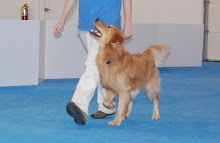
One of the classes this week was extra fun, only two dogs and both fairly advanced so we got to do even more recall games.
Still-Dog-Moving-Dog: We use variations of this in many of the classes I teach, from manners to reactive dogs. What the moving dog is doing depends on the type of class and goal of the exercise. Here, we had one dog sitting about 6' from the line of travel. A ring gate was placed in front of the team. That dog is reinforced for stillness and attention to the handler.
The moving dog was held by me and then released to his owner. Sometimes just running to the owner, sometimes catching up to the owner and running a bit.
Sometimes this is hard for the still dog, they want to join in the fun or play with the running dog. Sometimes it's hard for the running dog to see someone just asking to play and a person sitting on the floor.
But as they progress, we decrease the gate, remove the gate, and move the still team closer. Every 4-5 reps, we rotate who is still and who is moving.
And then, if we have enough helpers, we're ready for both teams to move
Taking Turns: And this is how we've introduced our flyball dogs to passing too. Dogs are restrained at opposite ends of their lanes. Owners will NOT be calling their dogs straight down the lanes, but angled out somewhat, so the dogs are running towards each other and so that the dogs being released are NOT sitting right next to a happy human.
The less reliable/ more novice dog is released first, and as he arrives at his owner, the second dog is called and released. After a few reps like that, we switch, the more novice dog is released second, and only after the first dog has been with his human a few moments (more time to settle down).
We work up to both dogs being released at the same time. And then change the paths until they are running right past each other.
We work up to both dogs being released at the same time. And then change the paths until they are running right past each other.
Very late in the game do we have dogs run parallel..... the visual cue of a calling human is so great, that we don't want the dogs to accidentally go to the wrong human early on. By treating that second owner as a distraction, we're teaching the dog to come to his person and only his person in this training context.




No comments:
Post a Comment